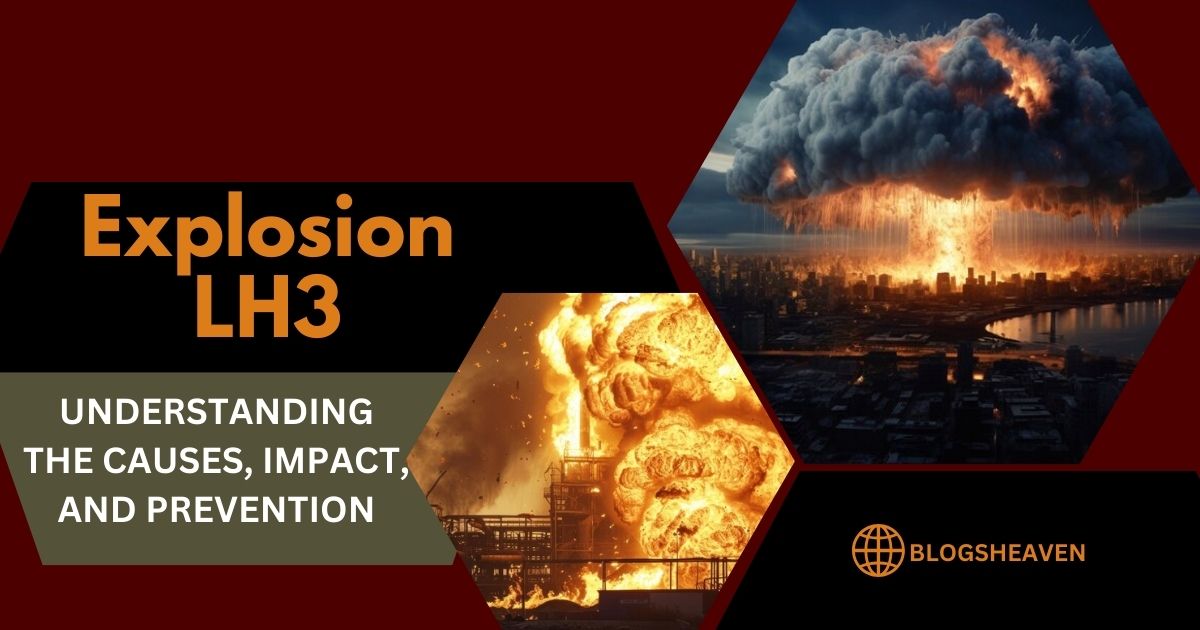Whether caused by nature or by humans, explosions are among the most destructive forces in the universe. There are many different kinds of explosions, but the one called “Explosion LH3” has scientists, engineers, and safety advocates worried. Although the name seems like something out of a science fiction book, familiarity with Explosion LH3 is essential for improving safety procedures and avoiding catastrophe. Explosion LH3 is the subject of this page, which delves into its origins, effects, and how to avoid it.
What is Explosion LH3?
A violent explosion Under certain physical and chemical circumstances, an explosive event known as LH3 can occur. The quick release of energy is a hallmark of this phenomenon, which is frequently set off by substances that are reactive or volatile. While the specifics of LH3 explosions aren’t always clear, the basic premise is that some compounds are unstable and, when disturbed, release a lot of energy. Businesses and safety experts must be alert to the dangers posed by these explosions since they happen so often in industrial settings.
Chemical Composition and Structure Behind LH3 Explosions
There are a number of chemical structures that contribute to LH3’s explosive properties. Subtle stimuli can cause compounds with volatile chemical structures to decompose, leading to the release of energy via explosion. When LH3 is bound to substances that are highly reactive when oxidized, for example, an exothermic process might be set off. Violent explosions are the outcome of these responses, which are both intense and spontaneous. For sectors dealing with delicate materials, knowledge of these chemical characteristics is priceless.
Common Industries and Environments Prone to LH3 Explosions
Industries dealing with chemical substances, like mining, petrochemicals, and pharmaceuticals, find LH3 explosions to be of special relevance. Many substances found in these settings have the potential to explode under certain circumstances. The danger is greater, for example, in chemical factories that handle combustible compounds or in refineries that handle volatile materials. The development of focused safety measures to prevent such disastrous occurrences is made possible by identifying susceptible areas.
The Science of Triggering Conditions
In order to determine what causes an LH3 explosion, it is necessary to examine the factors that contribute to instability. Variations in temperature and pressure, as well as contact with other reactive compounds, are among the many causes of explosions. For example, certain compounds can become instantly unstable when exposed to a sharp increase in temperature, leading to the release of energy. Industry efforts to reduce the occurrence of incidents with LH3 primarily center on the identification and control of these trigger situations.
Potential Impacts of an LH3 Explosion
The environment, human lives, and infrastructure are all at risk in the event of an LH3 explosion. Injuries to humans, including burns and other serious bodily traumas, are frequently the most tragic result. The explosions can also destroy property to a large extent, which might need expensive repairs or perhaps the closure of the affected institution. The explosions cause a lot of damage to the environment as well. The toxic chemicals that are discharged into the air and water can contaminate supplies, hurt animals, and disrupt ecosystems.
Examples of Real-World LH3 Explosion Incidents
There have been several explosions in the past that were thought to have been caused by reactive substances like LH3. For example, explosions in some chemical plants have been seen, which are consistent with LH3-like occurrences, in which volatile compounds exhibit unanticipated reactions. In order to create safer handling and containment techniques, scientists and engineers can gain a better understanding of the nature of these occurrences by studying these real-world cases.
Why Understanding LH3 Explosions is Critical for Safety
The foundation of safety standards in high-risk sectors is knowing the origins and effects of LH3 explosions. It is important to handle volatile substances with caution to avoid explosions like this. Doing so can save lives and resources. Prioritizing safety measures connected to LH3 allows firms to lower risks, avoid accidents, and make their workplaces and communities safer.
Current Technological Advances in Explosion Detection
Recent years have seen significant advancements in the identification of possible explosive hazards. The development of high-tech sensors and real-time monitoring systems has provided industry with the means to detect changes in pressure or temperature that indicate instability. Early identification of situations that may lead to an LH3 explosion is crucial for implementing preventative actions. Technologies like infrared sensors and gas detectors are important for this purpose.
The Role of Safety Training in Preventing LH3 Explosions
One of the main causes of industrial mishaps, such as LH3 explosions, is human mistake. Employee safety training is crucial for raising awareness and teaching correct handling techniques for hazardous materials. Identifying risks, properly storing items, and handling emergencies are all topics covered in training programs. Employees are always up-to-date on the newest safety measures thanks to training programs that are regularly updated.
Government Regulations and Compliance Standards
In an effort to reduce the likelihood of explosions involving dangerous materials, some government bodies have codified specific guidelines for their management. Following these guidelines is essential for keeping everyone safe and is also required by law. There are specific regulations for the disposal, handling, and storage of volatile substances, as outlined by organizations such as the EPA and OSHA. The prevention of LH3 explosions and the mitigation of their effects depend on the strict observance of these rules.
Common Misconceptions About Explosion LH3
Misunderstandings in industrial settings often stem from the many myths surrounding explosives such as LH3. Contrary to popular opinion, there are usually identifiable factors that set off these explosions. Another common misunderstanding is that reactive compounds may only be toxic in big quantities. In fact, even little amounts, if handled incorrectly, can cause severe harm.
Importance of Emergency Response Plans
Because accidents can still happen even with precautions taken, having a strategy in place for responding to them is essential. Included in these preparations are methods for communication and evacuation in the event of an LH3 explosion. Reducing fatalities and property damage through an efficient emergency response may be achieved by ensuring that staff and first responders are ready to handle the aftermath.
Preventive Measures for Reducing LH3 Explosion Risks
Safe storage methods, routine equipment inspections, and compliance with safety regulations are all necessary to prevent LH3 explosions. One way to lessen the chances of explosions is to keep reactive chemicals in places that are stable and regulated by temperature. It is also possible to avoid exposing unstable substances to reactive circumstances by keeping equipment in good repair and inspecting for leaks and wear on a regular basis.
Developing Safer Industrial Environments
Industrial areas should be designed with explosion hazards considered in order to provide safer settings. Installation of blast barriers, smart placement of equipment, and adequate ventilation are all part of this. Protecting workers and infrastructure from unintentional explosions is the goal of a well-designed industrial plant. Such precautions in the design process show that proactive safety management is important.
Future Trends in Explosion Prevention Technology
New developments in explosion prevention point to better safeguards in the future. Scientists are working on less reactive materials and devices with integrated safety measures. Additionally, there is promise in incorporating AI into monitoring systems; this is because AI can examine data trends to foretell and avert explosions. Sectors that place a premium on security and new ideas must purchase these technology.
Conclusion: Prioritizing Safety to Mitigate LH3 Explosion Risks
Understanding Explosion LH3 is essential for industries dealing with reactive materials. By learning about the triggers, impacts, and preventive measures, businesses can protect their assets, employees, and surrounding communities. Prioritizing safety is not just a legal requirement but also a moral responsibility. Through awareness, training, and adherence to best practices, LH3 explosions can be prevented, creating a safer future for everyone.
FAQs
What industries are most at risk for LH3 explosions?
Industries like pharmaceuticals, petrochemicals, and mining are particularly prone to LH3 explosions due to the reactive materials they handle.
Can LH3 explosions be entirely prevented?
While they can’t be fully eliminated, LH3 explosions can be significantly reduced through proper storage, handling, and monitoring practices.
What is the main cause of LH3 explosions?
The main cause is the instability of certain chemical compounds, which can react explosively under specific conditions.
Are there technologies available to detect LH3 explosions early?
Yes, technologies like infrared sensors and gas detectors help in identifying conditions that may lead to an LH3 explosion.
How can training help prevent LH3 explosions?
Training equips employees with the knowledge to handle reactive substances safely, reducing the chances of accidents due to human error.











